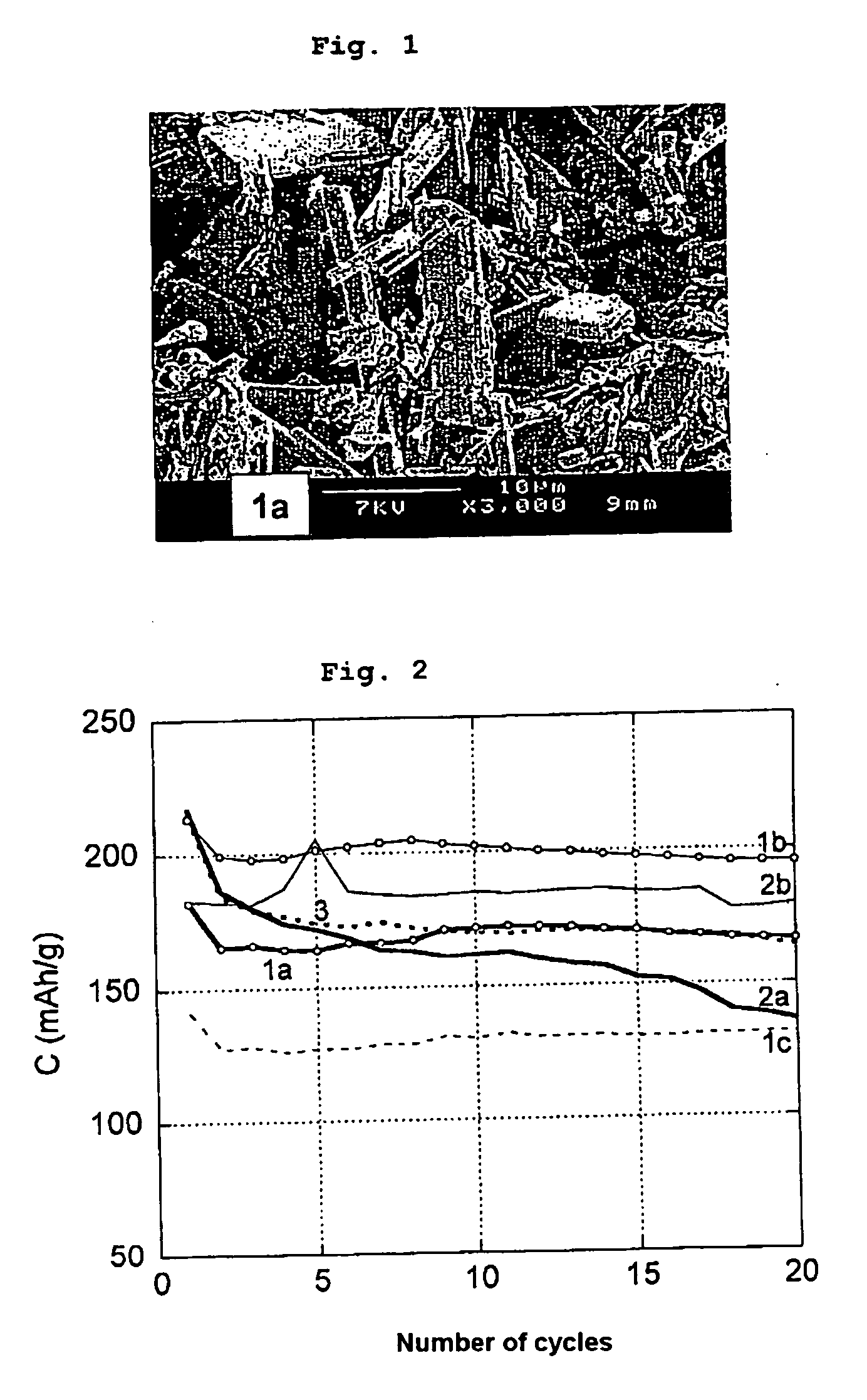Method For Preparing A Lithium And Vanadium Oxide Of The Li(1+Sg(A)) V3Op Type
a technology of lithium vanadium oxide and lithium vanadium oxide, which is applied in the field of preparing a lithium vanadium oxide of the li (1 + sg (a)) v3op type, can solve the problems of requiring a large amount of ion exchange resin, and requiring a large amount of precursors, etc., to achieve a simple and rapid method
- Summary
- Abstract
- Description
- Claims
- Application Information
AI Technical Summary
Benefits of technology
Problems solved by technology
Method used
Image
Examples
example 1
Preparation of Li1+αV3O8 from LiOH.H2O
[0057] An Li1+αV3O8 compound was prepared by adding LiOH.H2O and α-V2O5 in powder form to 25 ml of a 30% aqueous H2O2 solution in a 1 liter beaker with magnetic stirring.
[0058] Several specimens were prepared by varying, during the step of preparing the gelled precursor, the moment when the α-V2O5 and LiOH.H2O were added, and also the concentration of the V2O5 solution [V2O5] in mol / l. The particular conditions of the various trials are indicated in the table below.
Gelled[V2O5][LiOH•H2O]Addition ofAddition of LiprecursorSpecimenin mol / lin mol / lV2O5 after:salt after:obtained1a0.750.550 min0 minLiV3O8 gel1a′0.750.551 min0 minLiV3O8 gel1a″0.220.160 min1 minLiV3O8 gel1b0.220.160 min3 minLiV3O8 gel + LixV2O5gel1c0.220.160 min20 min LiV3O8 gel + LixV2O5gel
[0059] Specimen 1b corresponds to an addition of LiOH.H2O to a gel in the process of forming. Specimen 1c corresponds to an addition of LiOH.H2O to a gel already formed.
[0060] For each gel speci...
example 2
[0061] The operating procedure of Example 1 was repeated, in order to prepare three specimens, but replacing LiOH.H2O with LiCl (specimen 2a), LiNO3 (specimen 2b) and Li acetate (specimen 2c), respectively.
[0062] A 30 vol % aqueous peroxide solution containing 0.22 mol / l of V2O5 was used, to which the lithium salt was added after 3 minutes. In each case, an LiV3O8 gel was obtained after about 30 minutes.
[0063] A heat treatment similar to that of Example 1 was applied to each gelled precursor specimen.
example 3
[0064] The LiV3O8 compounds obtained after heat treatment in Examples 1 and 2 were used as active material for the positive electrode and their performance characteristics were tested in a laboratory Swagelok battery of the following type: Li / (EC+DMC+LiPF6) liquid electrolyte / (Li1+xV3O8+carbon+binder), operating at room temperature.
[0065] The results obtained for the various specimens are indicated in FIG. 2.
[0066] Curve 1c, corresponding to the Jinggang Xie product with late addition of lithium precursor to an already formed gel, shows the worst results—the capacity of the product remaining constant during cycling but remaining at a low level, of around 130 mAh / g.
[0067] Curve 2a corresponds to a compound obtained by the method of the invention, which is not stable in cycling.
[0068] In the case of curves 1a, 1b, 2a and 2b, which are obtained from compounds prepared according to the proposed method, it should be noted that the delivered capacities are similar and around 180 mAh / g...
PUM
| Property | Measurement | Unit |
|---|---|---|
| temperature | aaaaa | aaaaa |
| temperature | aaaaa | aaaaa |
| length | aaaaa | aaaaa |
Abstract
Description
Claims
Application Information
 Login to View More
Login to View More - R&D
- Intellectual Property
- Life Sciences
- Materials
- Tech Scout
- Unparalleled Data Quality
- Higher Quality Content
- 60% Fewer Hallucinations
Browse by: Latest US Patents, China's latest patents, Technical Efficacy Thesaurus, Application Domain, Technology Topic, Popular Technical Reports.
© 2025 PatSnap. All rights reserved.Legal|Privacy policy|Modern Slavery Act Transparency Statement|Sitemap|About US| Contact US: help@patsnap.com

